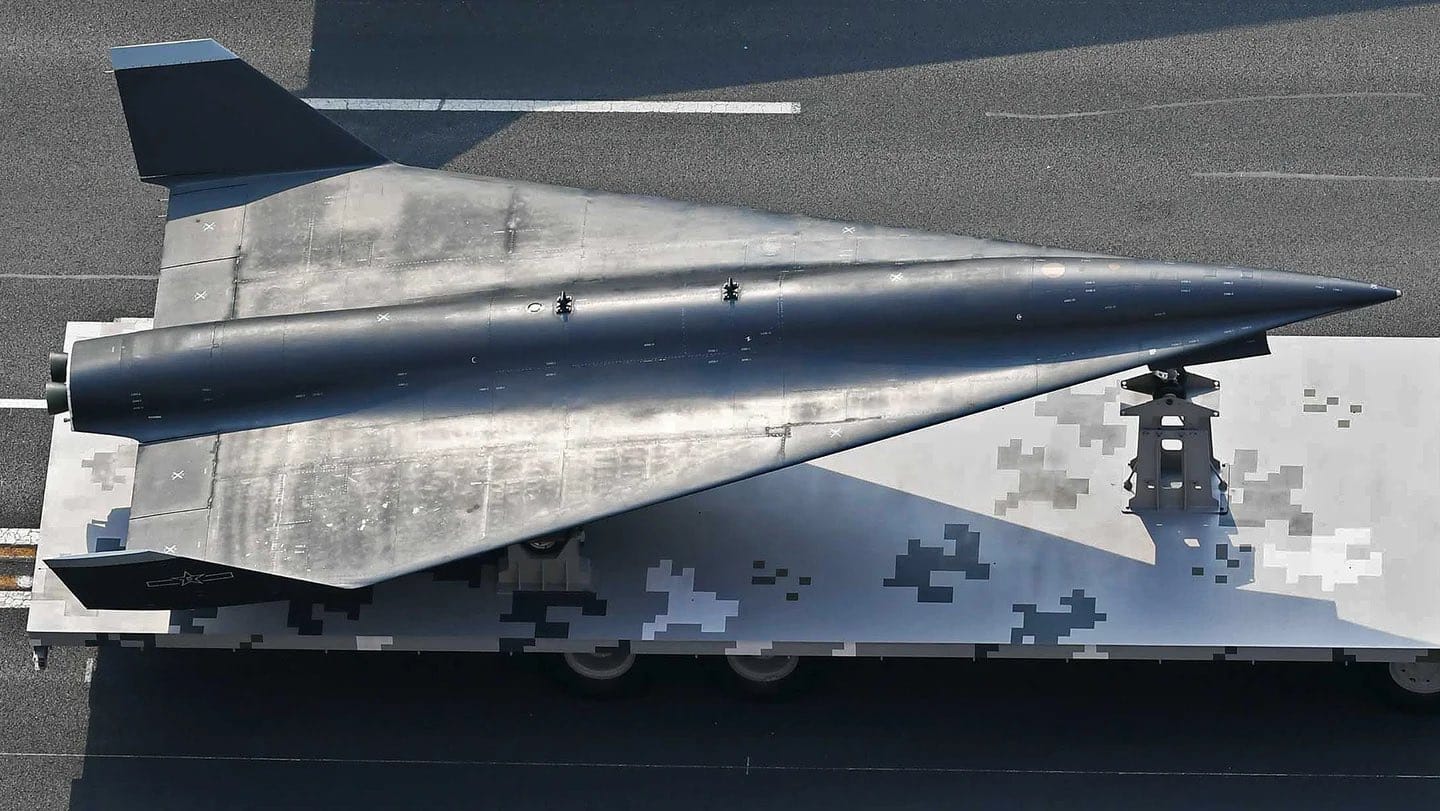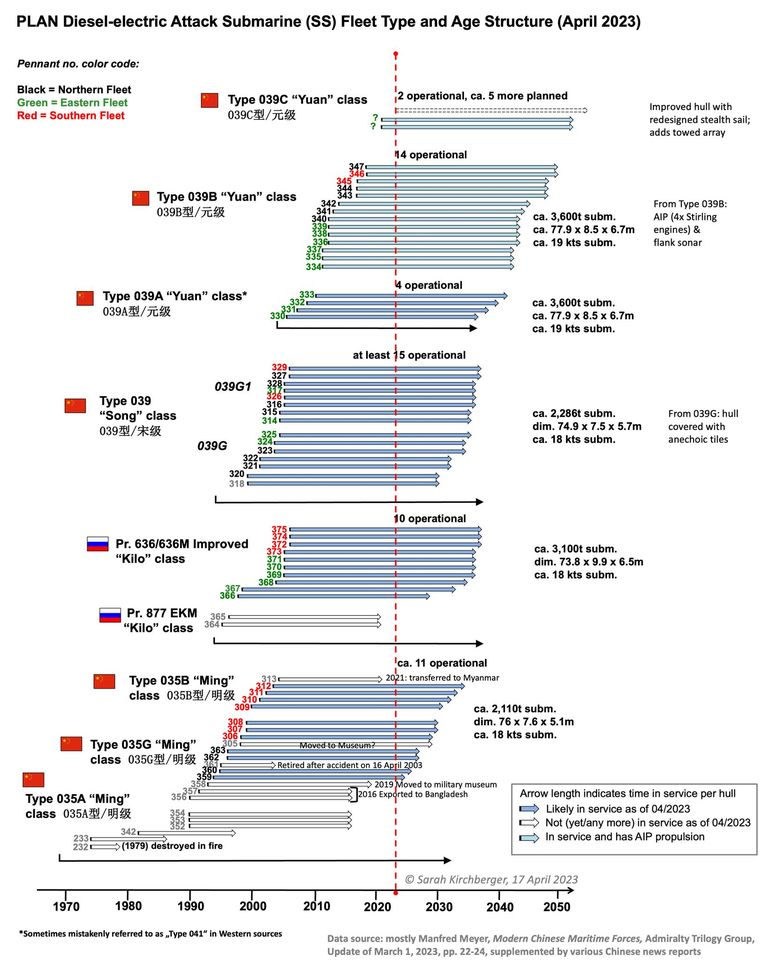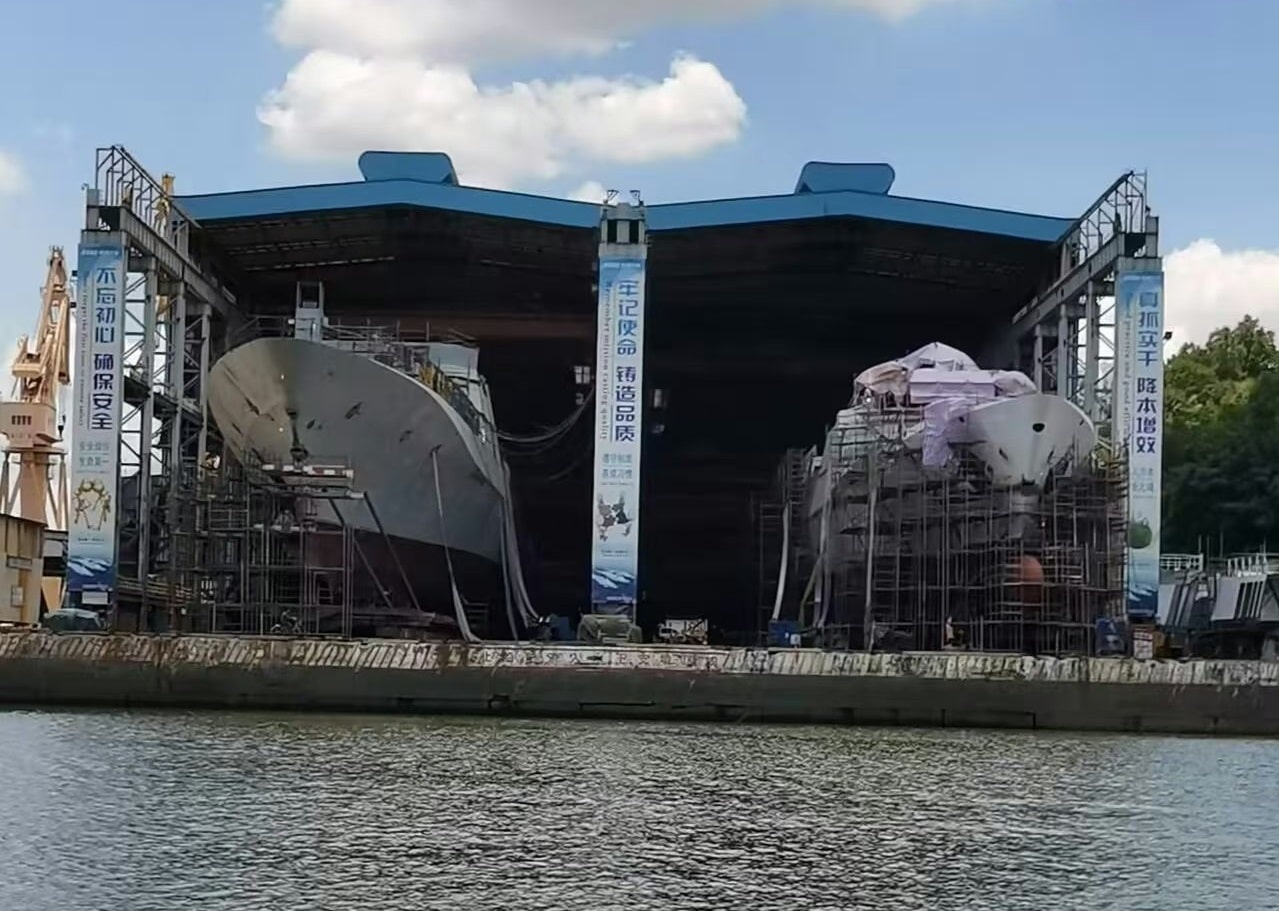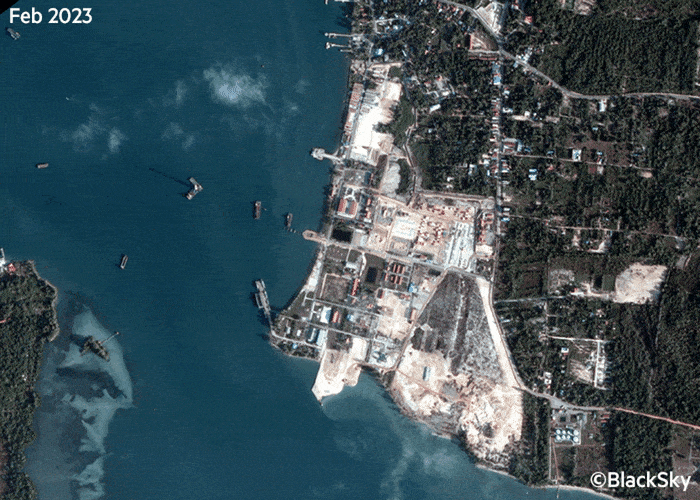These things will be the Uboats for WW3. Super underrated tech that's going to be extremely annoying and will kill lots of people.
You are using an out of date browser. It may not display this or other websites correctly.
You should upgrade or use an alternative browser.
You should upgrade or use an alternative browser.
With pump jet propulsior.
(corlobe (fr), mar.15)
China launches new nuclear-powered submarine, possibly Type 093B
China has launched an 8th Type 093 ("Shang" class) nuclear attack submarine at the Huludao shipyard in northern China between 13 and 18 January 2023. This is the second Type 093 submarine to be launched from the new assembly halls east of the port.On 11 January, the hull was placed from the dry dock onto a floating transfer platform, with a section behind the kiosk partially covered. On 18 January, after the launch, the submarine was moved to the fitting-out dock to the west of the port.It is not clear whether the submarine is equipped with a vertical launch system (VLS). A report issued by the US Secretary of Defense's office in 2021 indicated that an 093B nuclear attack submarine capable of launching cruise missiles (SSGN) was expected.Planet's satellite images show that the new hull is 110m long, with a beam of about 10m, similar to the seventh Type 093 hull launched in May 2022.Huludao Shipyard has returned to making Type 093 submarines after producing two Type 094 SSBNs between 2017 and 2021. According to satellite images, Type 093 submarines were built between 2000 and 2002 and between 2013 and 2017. /deepl
Yes, it looks like it. I hadn't noticed thatWith pump jet propulsior.

The Chinese Navy's 8th Aviation Brigade, based on Hainan Island, is now receiving an upgraded version of the J-11BH that features an AESA antenna radar (with a grey radome) and an improved avionics suite.
EW capability is also increased via pods.
EW capability is also increased via pods.

Leaked US Intel Suggests First Chinese WZ-8 Drone Unit Established - Naval News
China “almost certainly” established a first of a kind WZ-8 supersonic drone unit to perform ISR collection missions.

(metadefense, feb.2023)
China announces that the YJ-21 hypersonic anti-ship missile is in service aboard its Type 055 destroyers
When it comes to hypersonic missiles, the mainstream media seem to focus only on Russian advances, whether it be the Avangard hypersonic glider, the Kinzhal airborne missile or the 3M22 Tzirkon anti-ship missile, which made headlines a few weeks ago when the frigate Admiral Gorshkov undertook a deployment in the Indian Ocean, passing close to the European coast. However, Russia is not the only country to have achieved significant success in this area. North Korea has carried out several tests in recent months of a ballistic missile equipped with a hypersonic glider, while China admitted to service three years ago the DF-17 ground-to-ground missile of the same type, comparable in performance to the Russian Kinzhal. The same applies to the YJ-21 hypersonic anti-ship missile and its CJ-21 air-launched version, tested almost a year ago on board a Type 55 heavy destroyer and under the wings of an H-6N heavy bomber.
The existence of these two missiles derived from the DF-21D ballistic missile and topped with a hypersonic anti-ship glider is not new. They were observed in April 2022, and their supposed performance, as well as the tactical and strategic implications of their entry into service in the Indo-Pacific theatre, were analysed in an article entitled 'China's new YJ-21 and CJ-21 hypersonic anti-ship missiles are changing the game in the Pacific'. Nothing has fundamentally changed since that analysis, apart from two things On the one hand, the US Navy, but also the Japanese, Australian and South Korean navies, have committed themselves to rapidly deploying the new RIM-174 SM-6 missile on board their destroyers, the only Western missile, along with perhaps the Aster 30, that is effectively capable of intercepting this threat. On the other hand, the People's Liberation Army has just announced publicly that it has this missile, breaking the omerta about it that had lasted for many months.
Until now, the anti-aircraft and anti-ballistic defence of the large American and allied destroyers equipped with the AEGIS system relied on the SM-2 missile to intercept combat aircraft as well as cruise missiles, whether anti-ship or not, and possibly ballistic missiles in their terminal phase; as well as the SM-3 missile designed to intercept ballistic targets in transit flight thanks to a kinetic impactor capable of hitting targets up to 150 km in altitude. However, both missiles left a zone of vulnerability, between the 25km maximum altitude of the SM-2, and the 60km minimum altitude to engage the SM-3's kinetic impactor. In addition, the manoeuvrability and speed of hypersonic gliders such as the YJ/CJ-21 or 3M22 Tzirkon missiles make it impossible to intercept them with the SM-2 even in its most advanced version.
The SM-6, on the other hand, has been precisely designed to meet a large number of use scenarios, by combining the SM-3 booster to propel it as needed to great distances and/or very high altitudes and a nose cone composed of the radar seeker of the AIM-120C air-to-air missile and important aerodynamic manoeuvring capabilities inherited from the SM-2. It can thus be used against very fast and manoeuvring air targets up to a range of 240 km and especially an altitude of 35 km, well beyond the 25 km of the RIM-66 SM-2. Pending the entry into service of munitions specifically designed to meet the threat posed by hypersonic missiles with semi-ballistic trajectories such as the DF-21D or the Kinzhal, or equipped with hypersonic gliders such as the YJ-21 and the Tzirkon, the SM-6 is therefore the preferred solution of the US Navy and its allies, which is why, despite its price of almost $4.5m per missile, it has been ordered by the four major Pacific navies of the Western bloc.
However, the announcement made on the Weibo account of the Strategic Support Force of the People's Liberation Army, concerning the entry into service of the YJ-21 on board the Type 055 destroyers, marks a new stage in the arm wrestling match between Beijing and Washington in the Pacific, and in particular concerning Taiwan. There is a link between this announcement and the statements made a week ago by US Air Force General Michael A. Minihan, Commander of the US Air Mobility Command, who said that a conflict between the United States and China over Taiwan will occur by 2025. There is no doubt that the entry into service of the YJ-21 on Chinese destroyers, and the CJ-21 under the wings of H-6N bombers, gives Chinese forces a significant operational advantage in keeping at bay any US naval forces sent to protect Taiwan from a Chinese attack. On the other hand, there is little doubt that this advantage will only be transitory, with the massive arrival of the SM-6 and its specialised replacement on board US and allied destroyers, MQ-25 refuelling drones on board US aircraft carriers to extend their defensive perimeter, as well as the American hypersonic missiles currently under development. /deepl
Chinese Navy Submarine and Major Surface Ship Order of Battle
Below are some info-graphics provided by Sarah Kirchberger on the CIMSEC Internal Discussions Facebook page. I wanted to share them with you. (Not included in the listings are Chinese aircraft carriers, amphibs, and numerous frigates, corvettes, and other small combatants.) I have also provided her notes included with the three Facebook posts, but first some observations.
What does this have to do with the Coast Guard?
My expectation is that, if there is a major prolonged conflict with the Chinese, that the primary theater of operations will be inside and around the “First Island Chain” with Taiwan the critical center (Think Malta in the Mediterranean during WWII). The Chinese surface fleet is not likely to make significant operations outside this area. Chinese conventional submarines will also concentrate in this area but will also operate in the Straits that access the South and East China Seas.
The Chinese will make air and missile attack out to at least the “Second Island Chain,” including Guam.
The Chinese will want to attack US logistics and underway replenishment ships outside the Second Island Chain, both for the direct effect of reducing logistics available and for the secondary effect of drawing off units from the primary theater of action.
In the initial phase, the Chinese merchant and fishing fleets might be used to lay mines or even directly attack unarmed logistics and underway replenishment ships using containerized weapon systems supported by satellite targeting. (They might also launch cruise missiles into US ports as an opening salvo.) The Coast Guard Maritime Domain Awareness systems and cargo tracking programs will have a role in neutralizing the Chinese Merchant and distant fishing fleets.
The Chinese will operate at least some of their nuclear submarines (SSNs) (which would have difficulty dealing with USN SSNs) outside the Second Island Chain, perhaps as far East as the US West Coast. While MSC has been told not to expect escorts, the benefits of cutters with embarked Navy (probably Navy Reserve) ASW helicopters (and ultimately towed array systems) within effective helicopter range of a dispersed group of logistics ships to provide at least minimal ASW protection and rescue for the crews of the ships that are inevitably sunk, will quickly become evident. The cutters would hopefully be aided by Navy P-8 maritime patrol aircraft and any combatants making the transit trans-Pacific.
(None of the above reflects anything official, it is just the logic of the geography and the capability of the participants.)
Incidentally the format use below would be a good way for the Coast Guard to present its plans for major cutters.
--------------
Now to the Kirchberger posts:
After a long pause in making these info graphics, here is an overview of the *approximate* type and age structure of Chinese nuclear-powered submarines. I am decidedly less confident than with the surface fleet graphs about the accuracy of the information, which is why it took so long. Basically, I have decided to just visualize the data given in Manfred Meyer’s book ‘Modern Chinese Maritime Forces’ (March 2023 update) with some minor adjustments based on cross-checking with own research in Chinese newspaper reports. Despite the caveat, the graph might be useful to some, therefore posting it. I will periodically update as more information becomes available.
Blue arrow means boat is (most likely) in service as of April 2023, white means not yet or not any more in service, but may already be launched. Striped means: status unknown.
Feel free to use and republish (unaltered) with attribution. In case you find mistakes, I’d appreciate a note so I can make corrections during the next round!

Here is now also a visual overview of the PLA Navy’s conventionally powered submarine fleet. Blue arrow means boat is most likely in service as of April 2023,white arrow means not yet, or not any more, but may already be launched. The teal color indicates boats equipped with a (Stirling) AIP. Does not include test submarines (such as the Type 032), the unknown type sailless submarine, nor midget submarines.
Feel free to use and republish (unaltered) with attribution. In case you find mistakes, I’d appreciate a note so I can make corrections during the next round!

The speed of naval shipbuilding in China is such that it is easy to overlook that China has earlier this year commissioned the eighth and last of Flight 1 of its new cruiser, the Type 055 (never mind that the PLAN refers to it as a destroyer – at >12,000t full load, 180m length, and given its armament, it looks like a cruiser more than a destroyer).
Since the lead ship entered service in early 2020, China has commissioned altogether 8 of these Type 055 cruisers within a timespan of just 3 years! Further, 8 more are apparently already in the works, for a class of at least 16.
Here is an updated graphic overview of the type and age structure of China’s large surface combatants. Arrows indicate maximum time in service from commissioning until decommissioning – program start and build start is therefore not shown. 40 years per hull may be a bit long (30 years is common practice in most advanced navies), but in practice some navies have operated their surface combatants that long, so I choose to give the maximum conceivable length.
It is interesting to see how the arms embargo since 1989 initially disrupted naval shipbuilding, leading to multiple classes of just one or two hulls being built next to a Russian import, and how mass production finally took off from the Type 052D onward.
The Chinese official newspaper Global Times commented on the completion of the Type 055 class here: https://www.globaltimes.cn/page/202304/1289571.shtml
Feel free to use and reproduce this graph for non-commercial purposes (with attribution) and please let me know in case of mistakes so I can make corrections during the next iteration!

Its sad how PLAN is so far behind west on nuclear submarines.
Yet to have a properly sized SSBN or good enough SSN.
Hope 96 and 95 can fix that. But already late.
@LX1111
So you hope China can catch the West?Its sad how PLAN is so far behind west on nuclear submarines.
Yet to have a properly sized SSBN or good enough SSN.
Hope 96 and 95 can fix that. But already late.
@LX1111

China Maal...
Chale Toh Chand Tak Nahi Toh Raat Tak...




China Maal...
Char Din Ki Chandani Fir Andheri Raat....




Cracks found on new Chinese Aircraft Carrier.....




Making a direct copy of existing tech that flies is the least risky way to get an end product. No shame in this. This type of copying is legal as well.
With that said, there are differences, perhaps improvements, over the E-2. The tail for example. The copy is bigger and heavier, this guarantees some superiority over the E-2, like endurance.
Its sad how PLAN is so far behind west on nuclear submarines.
Yet to have a properly sized SSBN or good enough SSN.
Hope 96 and 95 can fix that. But already late.
@LX1111
If the new subs turn out to be good, they will compensate for the rest with a very high production rate.

China's New Type 054B Frigates Break Cover at two Shipyards - Naval News
Production of the Type 054B next generation frigate for the Chinese Navy (PLAN) is now well underway at two different shipyards...
(ft, jul.25)

Chinese base in Cambodia nears completion in challenge to US naval power
Satellite images show Ream facility will include pier for aircraft carriers

China has made significant progress building a naval base in Cambodia and is close to completing a pier that could berth an aircraft carrier, according to satellite imagery.
Images taken by BlackSky, a US commercial imagery company that has been monitoring the construction at Ream Naval Base, show a nearly complete pier that is strikingly similar in size and design to a pier that the Chinese military uses at its only overseas base in Djibouti.
The Pentagon believes China is building a facility in Cambodia to boost its ability to project naval power. China and Cambodia have denied that the People’s Liberation Army will have access to the base.
China has a bigger navy than the US but lacks the extensive international network of bases and logistics facilities needed to operate as a “blue water” navy that can sail around the world. Access to a base on the Gulf of Thailand would also provide a strategic advantage to China.
“There has been debate inside the [US] government about what exactly China would do with the base and why it would be better than a base in the South China Sea or Hainan Island,” said one former US intelligence official.
China has over the past decade built a number of military bases on reefs and reclaimed land in the South China Sea. But a base in another country could complicate any US military response in the case of a conflict.
“If the US and China went to war, the US could just bomb bases in the South China Sea. But in the case of this base, we would be bombing Cambodian territory,” said the former official.
Dennis Wilder, a former top CIA expert on the Chinese military, said the Ream base would have its “greatest strategic value were tensions in the South China Sea to boil over into a military confrontation”.
“[It] would also extend and enhance China’s naval operating capabilities towards the strategic shipping lanes of the Malacca Strait — a vital choke point in any conflict with the US and its regional allies,” Wilder added.
A spokesperson at the Chinese embassy in the US said Cambodia had stated that its constitution banned foreign military bases on its soil and that the construction was to strengthen Cambodia’s capacity. In March, China and Cambodia held their first naval exercise in Cambodian territorial waters.
China frequently responds to criticism by saying that the US military has hundreds of military facilities around the world, including in Asia.
Washington recently reached a deal with Manila that will provide the US military with access to four new bases in the Philippines. Lloyd Austin will this week become the first US defence secretary to travel to Papua New Guinea, in a visit that comes after the two countries signed a security pact that will provide the Pentagon with access to bases in the country.
“A naval base [in Cambodia] increases China’s regional influence in south-east Asia, suggesting the developing world is rapidly becoming an arena for US-China military competition,” said Evan Medeiros, a China expert at Georgetown University. “Africa and Latin America could be next.”
BlackSky says the first signs of construction of the pier, which is long enough to berth warships, including aircraft carriers, came in July 2022. China has rapidly built the pier since the end of 2022, images show.
Harrison Prétat, associate head of the Asia Maritime Transparency Initiative at the CSIS think-tank, said the Ream pier was similar to the Djibouti pier with both having a 335-metre section that could berth a Chinese aircraft carrier.
“The similarity to the Djibouti pier certainly is another indicator that China is likely involved in the construction,” said Prétat. “The dispute is about how the facilities would be used.” /end




